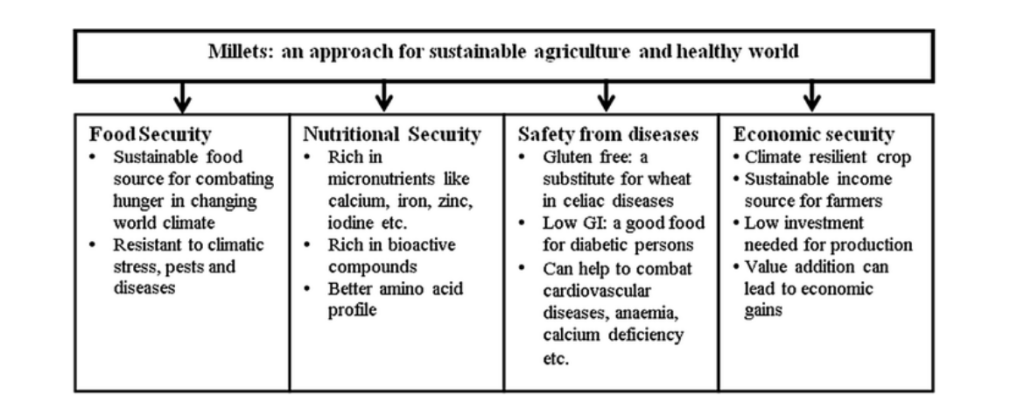Approach:
- Intro – mention 2023 as international year of millets.
- How millets help in achieving SDG targets ?
- Elaborate on the advantages of millet production & consumption.
- Give reference of states promoting millets.
- Conclusion
The UN has declared 2023 as the “International year of millets” and has called all stakeholders to provide policy support & attention to the nutritional benefits of millet consumption and their suitability for cultivation under adverse climatic conditions.
Millets have the potential to achieve SDG targets – i.e., SDG 2 (zero hunger), SDG 3 (good health and well-being), SDG 12 (sustainable consumption and production), and SDG 13 (climate action). According to International Crop Research Institute for Semi-Arid Tropics (ICRISAT), more than 90 million people in Africa & Asia depend on millets in diet. Although the global millet consumption has declined at a 9% rate, the millet market forecast for 2022-27 is promising. India dominates the global production at 41%, whereas consumption has been receding over the years.
Advantages : millets have multi-purpose usage. It is rain-fed crop with minimal fertilizer usage, no pesticide as they are less vulnerable to pest attack, seeds can be stored for years making it advantageous in drought-prone areas.
- They consume 70% less water than rice; can grow in half the time of wheat; and requires 40% less energy in processing. So, they are a good alternative in the wake of climate change, water scarcity, and drought conditions along with high nutritive value to provide sustainable food security. Millets are excellent source of anti-oxidants, helping enhance capability of probiotics. They play a role in body immune system – a solution to tackle childhood undernutrition & iron deficiency anaemia. It has higher nutritive value than other cereal crops. It helps lower cholesterol as it is rich in poly unsaturated fatty acids and omega-3 fatty acids.

- Sustainable diets are protective of biodiversity & ecosystems with low environment impact. Diversifying crop production by including more coarse cereals like millets can enhance food supply, reduce GHG emissions, and enhance climate resilience without compromising nutrition. A qualitative assessment of altering monsoon cereal production in India found millets as a viable option for food security & environmental resilience.
- The government incentivizes wheat and paddy through MSP & PDS. However, they being water intensive this further burdens the water table. It is to be noted that millets are not water-guzzling crops. They can thrive in relatively high temperatures (thermophilic) and reproduce in limited water supply (xerophilic). Also, millets require almost 6 times less water than rice and its maturation time is 45-70 days, half that of rice. Besides it shows high endurance in salinity, making it a climate resilient crop.
But, they have a short shelf-life depending on humidity, temperature and small market size. This calls for more awareness creation and setting up better storage facilities for its increasing longevity. Karnataka and Odisha have set examples by promoting millets consumption through mid-day meal, by distributing them in anganwadis and the PDS.
Given the nutritional and environmental benefits that millets have, ramping up its production and encouraging its consumption requires adequate policy intervention. A white paper on ‘Mainstreaming Millets for Nutrition Security’ in India (2021) provides a detailed framework for strengthening the entire value chain by addressing gaps, and replicating economically scalable models of other countries. It is time to unleash the potential of millets by creating awareness of its nutritional & ecological benefits to encourage a shift in consumer choices.
